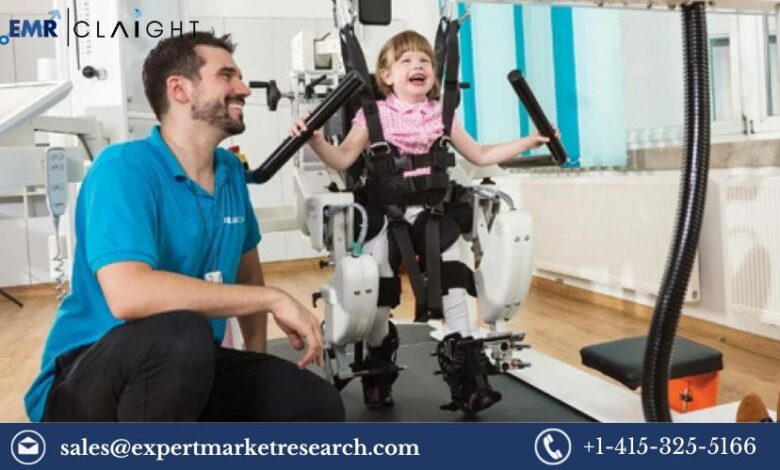Neurorehabilitation Devices Market Growth, Trends, and Key Players 2024-2032
Neurorehabilitation Devices Market Report & Insights 2032



Introduction
Neurorehabilitation is a crucial aspect of rehabilitation medicine, focusing on the recovery and improvement of neurological function after injuries or diseases affecting the central nervous system (CNS). As neurological disorders become increasingly prevalent worldwide, the demand for advanced neurorehabilitation devices is rising. These devices aid in the recovery of motor, sensory, and cognitive functions, enhancing the quality of life for patients. The global neurorehabilitation devices market is projected to grow at a robust compound annual growth rate (CAGR) of 12.1% from 2024 to 2032, driven by technological advancements, increasing prevalence of neurological conditions, and rising awareness of neurorehabilitation therapies.
Market Overview
Definition and Scope
Neurorehabilitation devices are specialized tools designed to support the recovery process of individuals with neurological impairments. These devices range from robotic systems and virtual reality tools to neuromodulation devices and brain-computer interfaces. Their primary goal is to improve neurological functions, including motor skills, sensory perception, and cognitive abilities, through targeted therapy and rehabilitation.
Current Market Size and Forecast
The global neurorehabilitation devices market was valued at approximately $X billion in 2023. With a projected CAGR of 12.1%, the market is expected to reach around $Y billion by 2032. This growth reflects the increasing adoption of advanced neurorehabilitation technologies and the expanding patient pool requiring neurological recovery solutions.
Market Growth Rate and Key Drivers
The market’s robust growth is attributed to several key drivers:
- Technological Advancements: Continuous innovation in neurorehabilitation technologies, such as robotic exoskeletons, advanced neuromodulation techniques, and immersive virtual reality systems, is significantly contributing to market expansion. These advancements offer more effective and personalized treatment options for patients.
- Increasing Prevalence of Neurological Disorders: The rising incidence of neurological conditions, including stroke, traumatic brain injury (TBI), and Parkinson’s disease, is driving demand for neurorehabilitation devices. As the global population ages, the prevalence of these disorders is expected to increase, further fueling market growth.
- Rising Aging Population: An aging population is more susceptible to neurological disorders and requires effective rehabilitation solutions. The growing elderly demographic is thus a major contributor to the increased demand for neurorehabilitation devices.
Impact of Technological Advancements
Technological advancements have revolutionized neurorehabilitation by introducing sophisticated devices that enhance therapeutic outcomes. Innovations such as brain-computer interfaces enable direct communication between the brain and external devices, while robotic rehabilitation systems offer precise and repetitive motion therapy. Virtual reality systems provide immersive environments for cognitive and motor training, making rehabilitation more engaging and effective.
Market Dynamics
Growth Drivers
- Increasing Prevalence of Neurological Disorders: Neurological disorders, including stroke, traumatic brain injury, and Parkinson’s disease, are becoming more common due to factors such as aging, lifestyle changes, and genetic predispositions. The need for effective rehabilitation solutions for these conditions drives the demand for neurorehabilitation devices.
- Rising Aging Population: The global aging population is more prone to neurological disorders and often requires specialized rehabilitation. As the number of elderly individuals grows, so does the demand for neurorehabilitation devices that cater to their needs.
- Advancements in Neurorehabilitation Technologies: Technological innovations, such as robotic exoskeletons, brain-computer interfaces, and neuromodulation devices, are enhancing the efficacy of neurorehabilitation therapies. These advancements contribute to the increased adoption of neurorehabilitation devices.
Restraints
- High Cost of Advanced Neurorehabilitation Devices: The development and maintenance of advanced neurorehabilitation devices can be costly. High costs may limit their accessibility and adoption, particularly in low- and middle-income regions.
- Limited Reimbursement Policies: In some regions, reimbursement policies for neurorehabilitation devices are limited or non-existent. This can restrict patient access to these technologies and affect market growth.
Opportunities
- Growing Demand for Personalized Rehabilitation Solutions: There is a rising demand for personalized rehabilitation solutions that cater to individual patient needs. Neurorehabilitation devices that offer customized therapy options have significant market potential.
- Expanding Healthcare Infrastructure in Emerging Markets: Emerging markets, with their expanding healthcare infrastructure, present significant growth opportunities for neurorehabilitation devices. Investments in healthcare facilities and increasing healthcare budgets in these regions can drive market expansion.
Challenges
- Technical Complexities and Integration Issues: The integration of advanced neurorehabilitation devices with existing healthcare systems can be technically complex. Ensuring compatibility and ease of use remains a challenge.
- Regulatory Hurdles and Approval Processes: Neurorehabilitation devices must undergo rigorous regulatory approval processes, which can be time-consuming and costly. Regulatory hurdles may impact the speed of market entry and adoption.
Get a Free Sample Report with Table of Contents
Key Market Segments
By Device Type
- Robotic Rehabilitation Devices: Robotic rehabilitation devices, such as exoskeletons and robotic arms, provide precise and repetitive motion therapy. They are widely used in stroke and spinal cord injury rehabilitation.
- Neuromodulation Devices: Neuromodulation devices, including deep brain stimulators and transcranial magnetic stimulation systems, modulate neural activity to improve neurological function. These devices are used in treating conditions like Parkinson’s disease and chronic pain.
- Virtual Reality-Based Devices: Virtual reality (VR) devices create immersive environments for motor and cognitive training. They are effective in engaging patients and enhancing rehabilitation outcomes.
- Brain-Computer Interface Devices: Brain-computer interfaces (BCIs) enable direct communication between the brain and external devices, facilitating motor and cognitive rehabilitation. BCIs are particularly beneficial for patients with severe motor impairments.
By Application
- Stroke Rehabilitation: Neurorehabilitation devices are extensively used in stroke rehabilitation to improve motor function, coordination, and speech. Technologies such as robotic systems and VR-based devices are commonly employed in stroke therapy.
- Traumatic Brain Injury (TBI) Rehabilitation: TBI rehabilitation focuses on restoring cognitive and motor functions. Devices such as neuromodulation systems and BCIs are used to support recovery and improve quality of life.
- Spinal Cord Injury Rehabilitation: Rehabilitation for spinal cord injuries often involves robotic exoskeletons and functional electrical stimulation devices to improve mobility and independence.
- Parkinson’s Disease Rehabilitation: Parkinson’s disease rehabilitation employs various devices, including deep brain stimulators and VR systems, to manage symptoms and enhance motor function.
By End-User
- Hospitals: Hospitals are major end-users of neurorehabilitation devices, providing comprehensive rehabilitation services to patients. Hospitals utilize a range of devices for different neurological conditions and recovery stages.
- Rehabilitation Centers: Specialized rehabilitation centers focus on neurorehabilitation therapies. These centers use advanced devices to provide targeted therapy and support patient recovery.
- Home Care Settings: Home care settings are increasingly adopting neurorehabilitation devices to provide patients with convenient and continuous therapy options. Devices designed for home use offer personalized and accessible rehabilitation solutions.
Regional Analysis
North America
- Market Trends and Growth Opportunities: North America is a leading market for neurorehabilitation devices due to advanced healthcare infrastructure and high adoption rates of new technologies. Growth opportunities include expanding product offerings and enhancing patient access to innovative therapies.
- Key Players and Their Market Share: Major players in North America include Biometrics Ltd, Kinestica d.o.o., and Ekso Bionics. These companies hold significant market share due to their established presence and innovative product portfolios.
Europe
- Regional Market Dynamics and Trends: Europe has a strong market for neurorehabilitation devices, driven by increasing awareness of neurorehabilitation therapies and advancements in technology. Key trends include growing investments in research and development and expanding healthcare facilities.
- Leading Countries and Their Contributions: Countries such as Germany, France, and the United Kingdom are leading contributors to the European market. These nations have robust healthcare systems and are early adopters of advanced neurorehabilitation technologies.
Asia Pacific
- Growth Potential and Emerging Markets: The Asia Pacific region offers significant growth potential due to its large population base and increasing healthcare investments. Emerging markets like China and India are experiencing rapid growth in the demand for neurorehabilitation devices.
- Major Developments and Investments: Major developments in Asia Pacific include expanding healthcare infrastructure and increasing collaborations between local and international players to introduce advanced neurorehabilitation solutions.
Latin America
- Market Size and Growth Prospects: The Latin American market for neurorehabilitation devices is growing, driven by increasing healthcare awareness and investments in medical technologies. Growth prospects include expanding access to advanced devices and improving healthcare coverage.
- Key Players and Industry Challenges: Key players in Latin America are focusing on expanding their market presence and addressing challenges such as limited healthcare funding and infrastructure constraints.
Middle East and Africa
- Market Landscape and Opportunities: The Middle East and Africa market is emerging, with growing opportunities in countries with expanding healthcare systems and increasing investments in medical technologies.
- Regional Developments and Growth Drivers: Key developments include increased healthcare spending and collaborations with international organizations to improve access to neurorehabilitation devices. Growth drivers include rising awareness of neurological disorders and advancements in healthcare infrastructure.
Competitive Landscape
Key Players
- Biometrics Ltd: Known for its innovative approach to neurorehabilitation devices, Biometrics Ltd offers a range of solutions that leverage advanced technology to support patient recovery.
- Kinestica d.o.o.: Specializes in robotic rehabilitation devices and is recognized for its contributions to enhancing motor function recovery in patients with neurological impairments.
- Ectron Ltd: Provides a variety of neurorehabilitation devices, focusing on integrating cutting-edge technology to improve therapy outcomes and patient engagement.
- BIONIK Laboratories Corp.: A leader in the development of robotic and AI-driven rehabilitation solutions, BIONIK Laboratories is known for its innovative products and solutions that support neurological recovery.
- Ekso Bionics: Focuses on exoskeleton technologies designed to assist patients with mobility impairments, offering advanced solutions for enhancing physical rehabilitation and independence.



